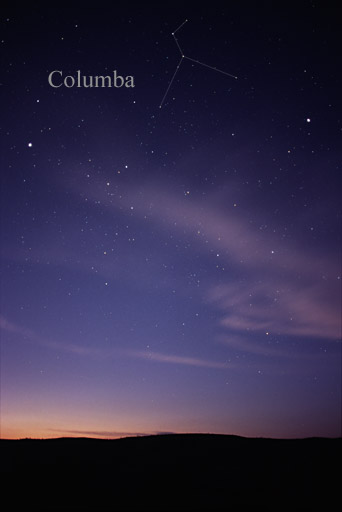
The Columba constellation – where celestial family drama meets cosmic bathroom humor! Let’s dive into a delightful corner of Chinese astronomy that proves even the heavens aren’t above a good potty joke.
A Family Affair in the Sky
In Chinese astronomy, Columba isn’t just a pretty dove fluttering across the night sky. Oh no, it’s a full-blown family reunion! We’ve got three generations represented here:
The Grandfather (Zhàngrén): Represented by α Columbae, also known as Phact. It’s like the celestial patriarch, probably complaining about how stars were brighter in his day.
The Son (Zǐ): Made up of λ, β, and γ Columbae. This is your middle-aged star, trying to balance his cosmic career with family life.
The Grandson (Sūn): Comprising κ, θ, and δ Columbae. The young whippersnapper of the bunch, probably wishing he was part of a cooler constellation like Draco the Dragon.
It’s like a sitcom waiting to happen – “Everybody Loves Columba,” anyone?
The Celestial Porta-Potty
But wait, there’s more! Because what’s a family gathering without someone making a mess? Enter the star μ Columbae, known in Chinese astronomy as Shǐ. And what does Shǐ mean, you ask? Brace yourselves… it means “Excrement.”
That’s right, folks. In the grand tapestry of the night sky, the Chinese astronomers looked up and said, “You know what this family portrait needs? A cosmic toilet!”
Imagine the conversation:
Grandfather star: “Back in my day, we didn’t have fancy constellations. We were just nameless dots!”
Son star: “Dad, please, not this story again.”
Grandson star: “Ugh, this family is so embarrassing.”
μ Columbae: “Pssst… I think someone forgot to flush the celestial toilet again.”
The Dove’s Dirty Secret
So next time you’re stargazing and spot Columba, remember: you’re not just looking at a peaceful dove. You’re witnessing a family squabble, complete with an unfortunately placed outhouse. It’s a reminder that even in the vast, majestic expanse of the universe, there’s always room for a little potty humor. The next time someone tells you to reach for the stars, maybe aim a little lower. You might just hit the cosmic commode!
| Four Symbols | Mansion (Chinese name) | Romanization | Translation | Asterisms (Chinese name) | Romanization | Translation | Western star name | Chinese star name | Romanization | Translation |
|---|---|---|---|---|---|---|---|---|---|---|
| White Tiger of the West (西方白虎) | 參 | Shēn | Three Stars | 屎 | Shǐ | Excrement | μ Col[1] | 屎 | Shǐ | (One star of) |
| Vermilion Bird of the South (南方朱雀) | 井 | Jǐng | Well | 丈人 | Zhàngrén | Grandfather | ||||
| α Col[2] | ||||||||||
| 丈人一 | Zhàngrényī | 1st star | ||||||||
| 丈人北星 | Zhàngrénběixīng | Northern star | ||||||||
| ε Col[2] | 丈人二 | Zhàngrénèr | 2nd star | |||||||
| 子 | Zǐ | Son | ||||||||
| λ Col[2] | 子一 | Zǐyī | 1st star | |||||||
| β Col[2] | 子二 | Zǐèr | 2nd star | |||||||
| γ Col | 子增一 | Zǐzēngyī | 1st additional star | |||||||
| 孫 | Sūn | Grandson | ||||||||
| κ Col[2] | 孫一 | Sūnyī | 1st star | |||||||
| θ Col[2] | 孫二 | Sūnèr | 2nd star | |||||||
| δ Col | 孫增三 | Sūnzēngsān | 3rd additional star |
Other Notes
In modern Chinese, Columba is known as 天鴿座 (tiān gē zuò), literally meaning “the heaven dove constellation.” This name reflects the Western interpretation of the constellation’s shape as a dove, showing how ancient Chinese astronomy has incorporated some Western astronomical concepts over time.
The modern constellation Columba straddles two important regions in traditional Chinese astronomy:
- The White Tiger of the West (西方白虎, Xī Fāng Bái Hǔ):
- One of the Four Symbols of Chinese constellations
- Represents the western direction and autumn season
- Associated with the element of metal
- Comprises seven “Mansions” or lunar positions
- The Vermilion Bird of the South (南方朱雀, Nán Fāng Zhū Què):
- Another of the Four Symbols
- Represents the southern direction and summer season
These quadrants are part of the Twenty-Eight Mansions system, which is similar to the Western zodiac.
Here are a few additional interesting points about Columba:
- Runaway star: Mu Columbae is a notable “runaway star” in this constellation, moving at an unusually high velocity through space.
- Exoplanet: The star WASP-63 in Columba has a known transiting planet.
- Deep sky objects: Columba contains the spiral galaxy NGC 1808 and the globular cluster NGC 1851.
- Visibility: Columba is best viewed in February from the northern hemisphere and during summer months from the southern hemisphere.
- Size: It’s the 54th largest constellation out of the 88 modern constellations.
- Family: Columba belongs to the Heavenly Waters family of constellations, which includes other “watery” constellations like Delphinus and Eridanus.

Leave a Reply